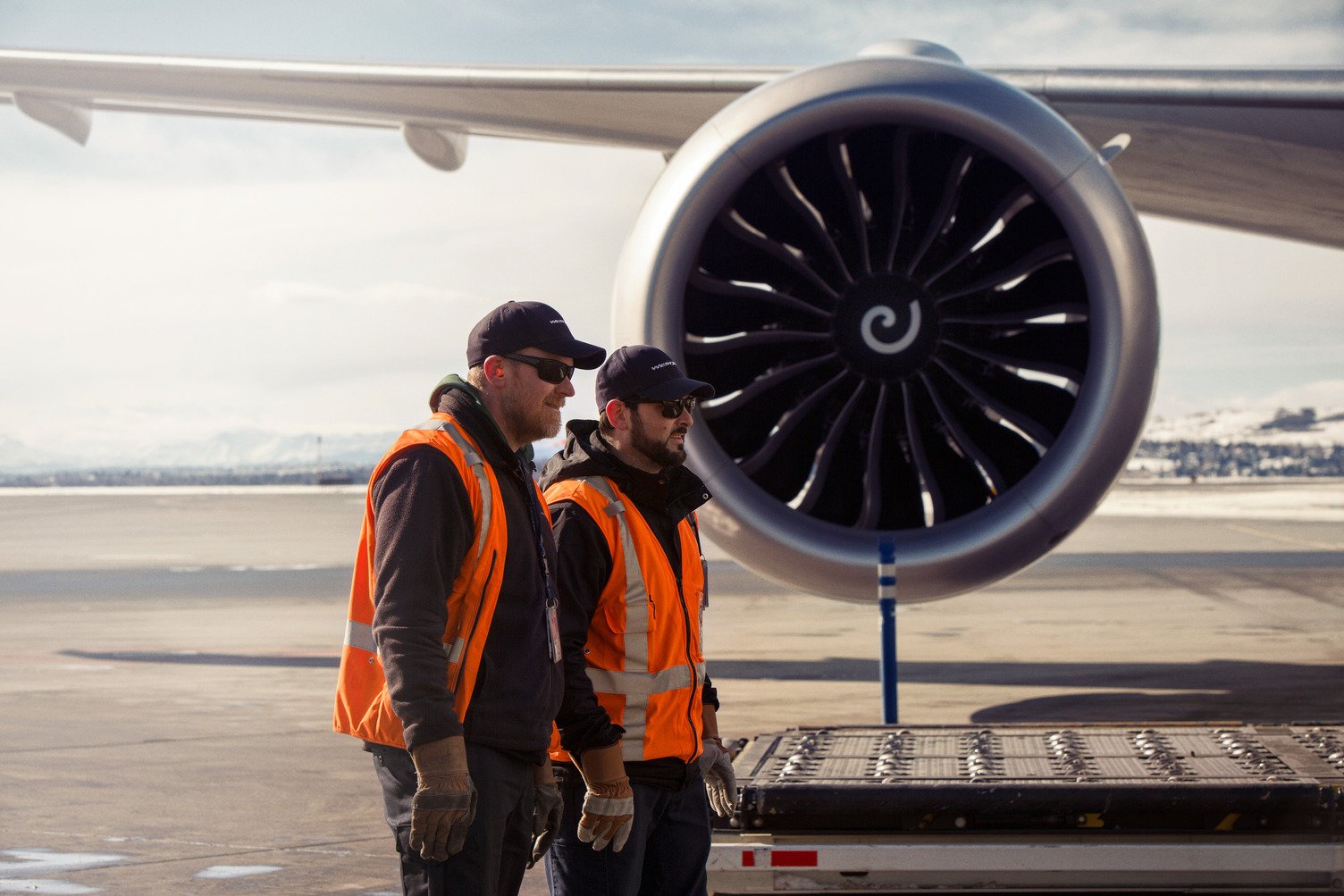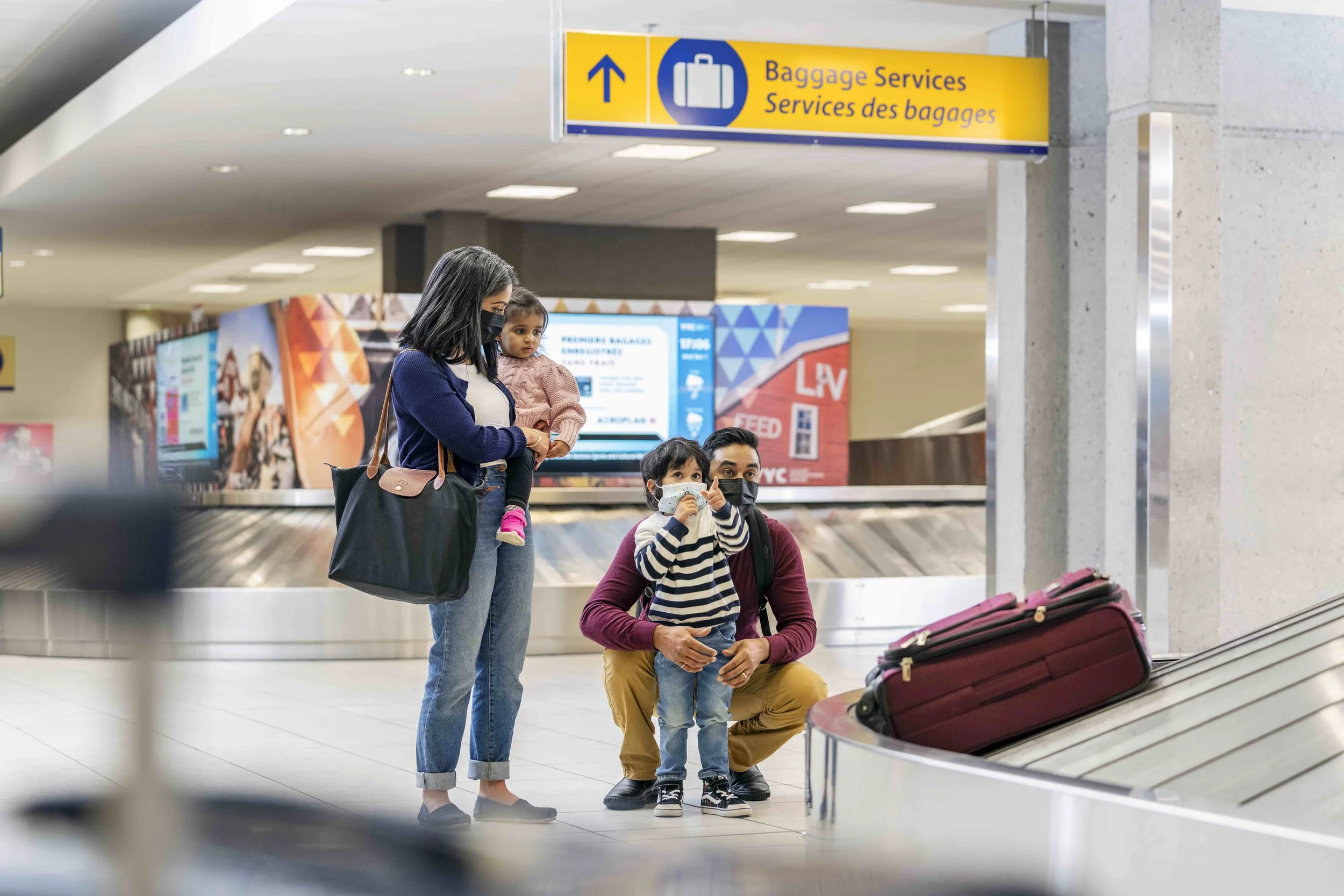4.0
Healthy People & Communities
In 2019, more than 50,000 jobs supported our airport community, and YYC was a major contributor to the prosperity of the Calgary region with a total GDP impact of $8 billion. In 2023, the airport hosted a record breaking 18.5 million passengers.
Springbank Airport (YBW) is Alberta’s second-busiest airport in terms of aircraft movements and the 6th-busiest aerodrome in Canada overall. Both airports are here to meet the region’s aviation needs, whether through commercial flights, importing or exporting cargo, providing a facility for flight training or a base for wildfire management, or through police and rescue operations.

Applicable United Nations (UN) Sustainable Development Goals (SDGs)
YYC aims to be a good neighbour and understands the importance of proactive measures to keep people and the natural environment safe from the impacts of airport operations and maintenance activities. Some of these proactive measures include an extensive water quality monitoring and reporting program, continuous improvement to emergency response plans, proper management and disposal of hazardous materials and contaminated waste, continuous noise monitoring and community engagement. A key potential impact of any airport is the noise associated with departing and arriving aircraft. This is addressed in this focus area.
By 2030, substantially reduce the number of deaths and illnesses from hazardous chemicals and air, water and soil pollution and contamination (3.9)
By 2030, provide access to safe, affordable, accessible and sustainable transport systems for all, improving road safety, notably by expanding public transport, with special attention to the needs of those in vulnerable situations, women, children, persons with disabilities and older persons (11.2)
By 2030, reduce the adverse per capita environmental impact of cities, including by paying special attention to air quality and municipal and other waste management (11.6)
By 2030, provide universal access to safe, inclusive and accessible, green and public spaces, for women and children, older persons and persons with disabilities (11.7)
4.1
Minimize Community Impacts From Aviation
YYC works closely with community associations, government and non-government agencies (including NAV CANADA) and airline partners to understand aviation noise concerns and implement a collaborative model to manage noise. This follows the International Civil Aviation Organization’s (ICAO) recommended ‘Balanced Approach’ for aviation noise management.
Aircraft Noise in and Around Calgary
The Calgary Airport Authority maintains a network for sound monitoring terminals around the community. More information on that system can be accessed from our Noise Management website. This is an important tool to understanding noise exposure and potential community annoyance with aviation noise. The City of Calgary also maintains noise exposure forecasts on their website, which are meant to inform land use decisions under Alberta’s Airport Vicinity Protection Area Regulation. That information is updated periodically following guidance from Transport Canada.
YYC & YBW Noise Program
The Calgary Airport Authority is sensitive to the impacts and concerns of Calgarians and, along with our partners, strives to mitigate and minimize noise when possible. YYC maintains a Noise Management Program that consists of noise monitoring, community engagement, noise concern investigation and regularly published noise and operations reports.
At YYC, we actively review industry-leading practices, as well as recommendations and suggestions from our consultative committees to determine if the implementation of those practices at YYC is feasible. The review process involves both discussions with our airline partners and NAV CANADA and are primarily focused on aviation safety. In some instances, a trial is proposed to evaluate the practice.
Tactics
We are reviewing our noise management plan to identify key areas to advance the Noise Management Program, ensure focus areas are still relevant and community concerns are addressed.
-
Published in the Canada Air Pilot (CAP) and primarily intended for jet aircraft, the Noise Abatement Procedures (NAP) specifies departure/arrival procedures, preferential runway determination, altitude restriction, night-time noise abatement rules and take-off or Vertical Noise Abatement Procedures (VNAP). YYC actively works with stakeholders to ensure noise abatement procedures are being adhered to and will be reviewing and updating noise abatement policies, such as run-up policies
-
YYC actively monitors aircraft noise in the Calgary region using a network of Noise Monitoring Terminals (NMTs). Currently, there are 16 NMTs located in neighbouring communities that captures both aircraft and community noise data. Airport operations data is updated regularly and can be found on our website. In 2019, the airport acquired a mobile noise monitoring terminal to be deployed in communities that are temporarily affected by a change in air traffic programs. This will help YYC capture data in communities that don’t have a permanent NMT and obtain a better understanding of the noise profile around the city
-
Investigation and response to concerns often involves verifying information with NAV CANADA and the aircraft operator. If we suspect that any operational restrictions have been infringed, we will contact the airline operator for information. We will be restructuring our noise concern response process by triaging concerns through the 24-hour Integrated Operations Centre (IOC) which will improve the service level to community members
4.2
Contribute Positively to Health and Wellbeing
The health and wellness of YYC Crew, in all aspects of their lives, is of primary importance. Our people are our greatest asset, and a healthy, happy and committed workforce is vital to our success.
The Calgary Airport Authority is proud to be recognized as a Top Employer in Canada and Alberta in 2024, marking the 14th consecutive year landing a spot on these lists. The areas measured include:
Physical workplace
Work atmosphere & social
Health, financial & family benefits
Vacation & time off
Employee communications
Performance management
Training & skills development
Community involvement
Employee Wellness
Our approach to employee wellness reflects the multi-faceted nature of wellbeing. Our wellness strategy is based on five key elements of wellbeing: Physical, Emotional, Social, Financial, and Work Life. Supporting these elements builds the resilience, engagement, and health of our workforce.
Physical Wellbeing: Healthy choices that support the ability to function with energy. To support employees’ physical wellbeing, YYC Crew members receive corporate rates on Goodlife Gym memberships.
Emotional Wellbeing: Capacity to successfully handle life stressors with resilience. All YYC Crew members can access an employee assistance program, Inkblot, to receive unique, confidential counselling services to support emotional and mental health.
Social Wellbeing: Developing and sustaining meaningful relationships that build a sense of community and belonging. At YYC, there are many social connection opportunities offered to crew members including sport tournaments, holiday themed contests, and social events through the year.
Financial Wellbeing: Ability to confidently manage financial life to prepare for the future, increase security, and reduce stress. In additional to counselling offered through Inkblot, YYC Crew members receive discounts through various services to help reduce financial stress.
Work Life Wellbeing: Positive experiences that produce pride, satisfaction, and value. YYC values and encourages a healthy work life balance for Crew members and offers options such as flex days, flexible working arrangements, compressed work schedules, and hybrid work model.
Our Develop our People strategy advances these elements through programs and initiatives. Key priorities include:
Supporting the Diversity, Equity, and Inclusion (DEI) strategy and Inclusion committee including DEI training for all senior leadership
Supporting initiatives of the established Inclusion Committee and Women@YYC Group
Offering Indigenous Cultural Competency Training to all crew members
Continuation of LinkedIn Learning offering
Community Engagement and Contributions
YYC Crew have been enthusiastically collaborating on additional sustainability efforts. 2021 marked several new initiatives aimed at strengthening the integration of sustainability into our business decisions were launched.
We developed important collaborations and partnerships that will advance sustainability efforts locally, and throughout the aviation sector. Those efforts included:
Being a founding member of the Canadian Council for Sustainable Aviation Fuels
Chairing the Calgary Climate Panel (an advisory group to The City of Calgary)
Membership in the Canadian Airports Council and Airports Council International – North America PFAS working groups
Becoming a founding partner of the Calgary Region Hydrogen Hub being coordinated by the Transition Accelerator
Working with the SAIT Integrated Water Management program to develop teaching materials and student practicum opportunities
Partnership with the University of Calgary to conduct important research on groundwater-surface water interactions in urban environments
Continuing support for the Nose Creek Watershed Partnership
Empowered and inspired by our values, YYC continues to support our communities and environment through:
20 years of partnership with The Mustard Seed
Partnership with Pet Access League Society to offer Pre-Board PALS to passengers to enhance travelling guests’ emotional wellbeing
32 years of our White Hat Volunteers providing assistance and hospitality to guest of YYC
Supporting women in aviation in partnership with Elevate Aviation where YYC’s Chief Operating Officer, Chris Miles, is a member of the board
Four years of partnership with #NotinMyCity on human trafficking prevention through training in front-line roles including training for all YYC Crew members
Listening and engaging with community association representatives through a community consultative committee
Meeting the needs of the Canadian Transportation Association Accessible Transportation for Persons with Disabilities Regulations through an accessibility advisory council
Championing and fostering the use of Canada’s Official Languages in services to the public
Focus Areas











